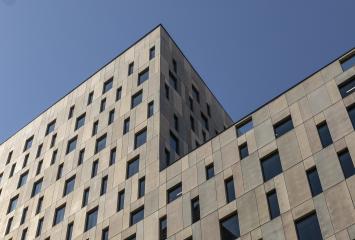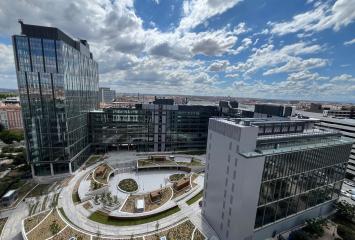Reducing energy intensity: commitment number 1 of Colonial's Sustainability Decalogue
At Colonial we have always shown a total commitment to environmental sustainability. And this has mainly translated into two movements: the development of a Sustainability Decalogue and the formation in 2020 of a Sustainability Committee aimed at supervising the implementation of each of the principles of the Decalogue in the assets we own. The first of these, which we are going to talk about on this occasion, is the principle of reducing energy intensity in buildings by 10% by 2030. A goal aligned with the objectives of the Paris Agreement, transcendental in the process of mitigating anthropogenic climate change.
Measures adopted to reduce energy intensity
Reducing energy intensity is one of the two mechanisms through which we can reduce the emission of greenhouse gases associated with energy consumption. The other is the substitution of polluting fossil fuel energies for green renewable energies, another of the principles of our Decalogue, which we will discuss on another occasion. Returning to reduction, at Colonial Group we have conceptualized and implemented a series of specific measures for this purpose, which are largely responsible for the fact that 95% of our portfolio of offices in operation have official sustainability certifications.
Among this package of measures are the replacement of air conditioning systems with more efficient alternatives, improved control of automated building processes through the installation of advanced management systems such as PropTech 2.0, a commitment to LED lighting and more efficient lighting regulation systems, and the installation of solar photovoltaic systems for self-consumption. All of this has a double impact: reducing energy intensity and reducing carbon dioxide emissions. Many sustainability measures we take at Colonial cover various ecological principles.
Colonial's current status of the energy intensity rate
Compliance with some of the sustainability goals we set ourselves at Colonial in 2018 was planned for 2050, but the productivity of the Sustainability Committee in particular and the company in general has made it possible to bring many of them forward to 2030. This is the case of the energy intensity reduction target. Specifically, and according to the data analyzed in 2021, the last full year available, the intensity of energy consumption in our properties has decreased by 3% compared to 2019 data, in a pre-Covid period of normality. The predictions are very positive. They encourage us to continue in this way.
Buildings in the Colonial catalog that exemplify this principle
This 3% reduction in energy consumption intensity represents an average. At the end of the day, each building we acquire has unique characteristics that make it easier or more difficult to achieve this goal. In that sense, at Colonial we carry out a prior analysis of the energy efficiency potential of office buildings before acquiring them to guarantee minimum progress in sustainability. From there, some buildings stand out above others because of the opportunities they provide in this aspect. Sometimes because of their location. Others because of the materials they are made of. And others because of special design features.
One such example is Wittywood. This office building, the first in Spain to be built with massive wood, reduces the average energy consumption intensity of our assets thanks precisely to wood, a material that reduces energy needs due to its thermal insulation capacity. Torre Marenostrum is another example, in this case because of its large windows, which define the entire building and guarantee a constant entry of sunlight that reduces dependence on electricity and heating. Sant Cugat Nord and Illacuna, both equipped with Building Management Systems, are other particularly efficient buildings.
Colonial's path towards total sustainability has just begun, but we have already come a long way. We will continue to implement solutions and technologies that further reduce the intensity of energy consumption in our office buildings and to invest in new assets born out of our commitment to sustainability. In the next installment of this series, focused on the principles set out in the Sustainability Decalogue, we will discuss our goal of reducing our carbon footprint by more than 75%, which places us among the most ambitious European real estate companies from an environmental protection standpoint.

